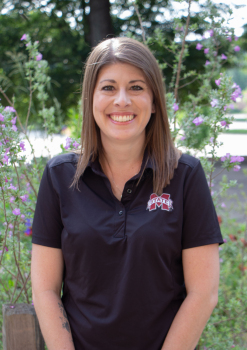Stephanie Cunningham
As a native of the Chicago suburbs, Stephanie Cunningham doesn’t take Mississippi’s winters for granted—especially given how much time her research can require outdoors. As a postdoctoral associate and wildlife ecologist at Mississippi State University, Cunningham knows firsthand how weather conditions can shape both her comfort and the success of her fieldwork.
“While I’m happy to be in the field every now and then, this summer humidity makes me glad that most of my time is spent at the computer,” Cunningham said.
Cunningham is working on a project to develop habitat suitability maps for white-tailed deer and wild pigs in Mississippi. The creation of these maps is formed by linking GPS collars and satellite-based land cover to predict where animals are more likely to be on the landscape. Using the predicted relationships between known locations and land cover, Cunningham creates visual representations that can help support management actions. The work has allowed her to build valuable partnerships with biologists from the Mississippi Department of Wildlife, Fisheries and Parks, and participate in herd health checks and deer population counts utilizing thermal cameras.
Her passion for working with nature and wildlife began during childhood family vacations to multiple national parks. She initially pursued a bachelor's degree in zoology with a concentration in zoo and aquarium science, but her career path took an unexpected turn during a transformative two-year experience in Africa.
"I discovered that I enjoyed the research components more than animal husbandry," she said.
This revelation led her to pivot toward field research, and during her master's program, she developed a particular excitement for statistics and quantitative ecology.
"I enjoy working on statistical puzzles and challenges related to wildlife, which I guess makes me a bit of a nerd, but I’m ok with that," Cunningham laughed.
During her first year at MSU, Cunningham collaborated with the United States Department of Agriculture-Agricultural Research Service on groundbreaking behavioral research. Using GPS collars and accelerometers on cattle, she worked to identify specific animal behaviors through data analysis, similar to how a smartwatch might identify when the wearer is engaged in exercise, as certain motions can be indicative of specific behaviors or actions.
By comparing direct observations with collected data, Cunningham could accurately classify various behaviors, providing valuable insights into what cattle were doing beyond the range of human observation. This innovative approach proves particularly useful for managing livestock on large rangelands or monitoring wildlife with extensive travel ranges. Last summer, she had the opportunity to visit the actual rangeland where the cattle she studied were located, bringing her research full circle.
Cunningham is also involved with the Quantitative Ecology and Spatial Technology Lab (QuEST Lab) within the Forest and Wildlife Research Center, where individuals ranging from undergraduates to faculty gather weekly for knowledge sharing.
"We learn from each other, get feedback, and discuss different aspects of wildlife ecology, management, and conservation. It's a really great sense of community," Cunningham said.
When she's not analyzing wildlife data or conducting field research, Cunningham enjoys walking her dog and pursuing creative outlets through arts and crafts, particularly diamond art. She's also currently learning how to box, adding a new physical challenge to her list of interests.

